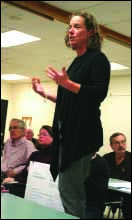CHARTING FUTURE: 90 Citizens Discuss What Might Be
By JIM KEVLIN • The Freeman’s Journal
Edition of Thursday, Oct. 9, 2014
When you hear “Cooperstown,” what one word comes to mind?

The 90 people at the Design Charrette Monday, Oct. 6, answered: Beautiful, parochial, idyllic, struggling, lucky, tired, over-baseballed, jobless, pastoral, shrinking, safe.
Asked what they hope to see their community become in 10 years, they replied (verbatim, as written on flip charts): vibrant but quaint, progressive in its energy use, affordable, thriving, expanded waterfront, year-’round energy.
Asked what issues need to be addressed, they said: expanded tax base, strong downtown group, housing price/quality, more parking, fewer prohibitive ordinances, population growth, worker housing.
Asked what actions will take us there, they declared: improved access to waterfront, a multi-purpose theater, more involvement of museums/HoF in the community, active night life, attracting young people, rapid transit from parking lots.
Of necessity, this is just a fraction of all the inputs delivered in the two-hour session in the Cooperstown Central Middle/High School cafeteria.
The lists complete, the 10 consultants from Elan Planning, Saratoga Springs, which is conducting a community visioning effort on behalf of the Village of Cooperstown and the county Industrial Development Agency, provided participants with a list of symbols denoting great views, community icons, destinations.
The 90 then marked up the maps.
At evening’s end, Elan’s founding principal Lisa Nagle, energized by what she’d heard, declared, “A lot of community happened around this room.”
Tuesday the 7th and Wednesday the 8th, her teamwas collating the inputs, seeking common trends in the responses, and analyzed the maps to identify key community resources.
If you see this in time, head back to the CCS cafeteria at 6 p.m., the evening of Wednesday 8th to hear Nagle’s team present preliminary conclusions (or read a news report about it later in the evening on www.allotsego.com)
In addition to the analyzing, the day after the Design Charrette the team conducted “stakeholder interviews,” at 2 p.m. with the arts community, including representation from The Fenimore Art Museum; at 3, with environmental groups and, at 4, with hospitality and tourism people.
Going forward, further conversations are planned with Bassett Hospital, Village Hall and other interests. “The idea is to really cast a broad net,” said Nagle.
The goal is that, by next spring, the village will have been able to update its 1994 Comprehensive Master Plan, and to have in hand market data that will allow investment and development supported by the master plan to be pursued.
Key to how thorough the effort can be will depend on the next round of CFA grants. CFA refers to the “common funding application” required to access state economic development funds. Governor Cuomo is expected to announce those grants Oct. 15 or 16.
If all goes as hoped, Nagle said the planning effort will feature a number of community meetings between now and the plan’s completion to ensure it reflects local residents’ consensus views to the degree possible.
Monday’s meeting came to order shortly after 6 p.m. Nagle outlined the many benefits of consensus, concluding with the most practical one: If a community can agree on what it wants, its state and federal grant applications are moved to “the top of the pile.”

